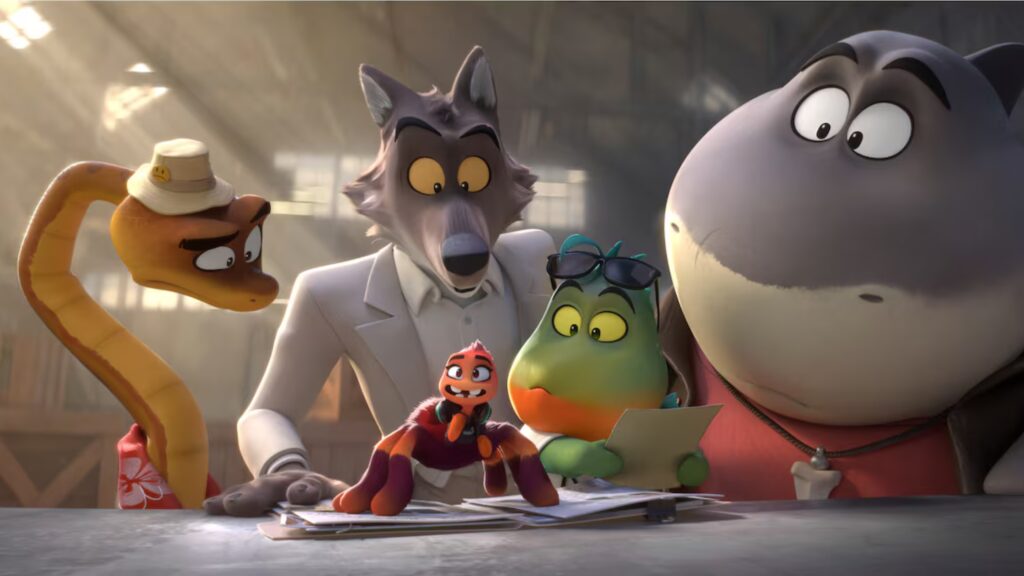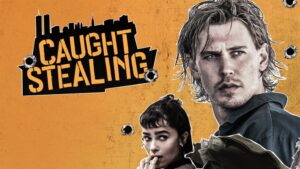Introduction & Premise of The Bad Guys 2.
The Bad Guys 2 is the animated sequel to DreamWorks’ 2022 film The Bad Guys. Directed by Pierre Perifel (with co-direction by JP Sans), the sequel drops the reformed animal criminals back into a high-stakes heist, this time pitting them against a cunning “Bad Girls” trio.
In many ways it leans into classic heist tropes — “one last job,” double crosses, glamorous gadgets, betrayals — but frames them through the lens of redemption, identity, and reputation. As such, it sits squarely as an animated heist action-comedy with heart — meant for families but with enough cleverness and subtext to engage adult viewers too.
Cast, Main Characters & “Means Character of The Bad Guys 2 Movie”
Cast & Principal Voices
The principal cast of The Bad Guys 2 includes returning voices from the first film and several new additions:
- Sam Rockwell as Mr. Wolf
- Marc Maron as Mr. Snake
- Awkwafina as Ms. Tarantula (aka “Webs”)
- Craig Robinson as Mr. Shark
- Anthony Ramos as Mr. Piranha
- Zazie Beetz as Diane Foxington
- Alex Borstein as Officer Misty Luggins
- Richard Ayoade as Professor Marmalade
- Lilly Singh as Tiffany Fluffit
- New voices: Danielle Brooks (as Kitty Kat), Natasha Lyonne (as Doom / alias “Susan”), Maria Bakalova (as Pigtail Petrova)
So counting major speaking roles, there are around a dozen or so core cast members. (If you include smaller bit parts, guards, etc., the total voice cast is larger.) But in terms of narrative weight, those above are the key players.
The “Means Character” / Central Protagonist
If by “means character” you mean the central viewpoint or emotional anchor, that is Mr. Wolf (Sam Rockwell). He carries the film. The narrative largely orbits around Wolf’s struggle: trying to remain reformed and accepted by society, resisting old criminal impulses, and reconciling his love life (with Diane) with public perception.
Though the gang is ensemble in nature, Wolf acts as the moral barometer — his choices, insecurities, and leadership define much of the emotional thrust. Through him, the film asks: can someone truly change? And what does it cost socially and personally to try?
Box Office & Financials.
Budget & Grosses
- Reported production budget: about US$ 80 million.
- Box office performance (as of latest data):
• Domestic (U.S. + Canada): approximately US$ 80.9 million.
• International / other territories: approx. US$ 134.8 million.
• Worldwide total: about US$ 215.7 million.
Other sources report figures in the realm of $228 million total gross (likely later tallies). The film’s opening weekend in the U.S. was US$ 21,995,715 in ~3,852 theaters.
Thus, the film roughly doubled its production budget in gross, which is a decent performance, though marketing and distribution costs eat into profits. It appears to have been a moderate success — not a breakout juggernaut but a solid performer.
Box Office Trajectory & Comparisons
- The opening was solid but not spectacular; some critics noted it “fell short of expectations.”
- The film had stronger legs internationally, which helped offset domestic softness.
- Given the budget and box office, The Bad Guys 2 likely turned a profit, especially considering downstream revenue (streaming, home video).
- For comparison, the first Bad Guys (2022) grossed about US$ 250.8 million globally on a similar budget.
So the sequel’s performance is somewhat lower than the original’s, but not disastrous. It may reflect the usual common trend: sequels often struggle to match the novelty and “buzz” of the original, especially in animation markets saturated with franchise entries.
Niche, Genre & Thematic Domain.
Genre / Niche
The Bad Guys 2 occupies the niche of family-friendly animated heist / caper comedy — not quite “kid movie only” but also not adult-only. It targets a cross-generational audience: kids enjoy the spectacle, slapstick, bright characters; adults enjoy the wit, references, and subtext.
In terms of storytelling style, it leans into meta humor, genre subversion, and moral ambiguity (for a kids’ film). Its niche is that “heist movie made for families” — something like Ocean’s Eleven reimagined with talking animals, but with emotional stakes and redemption arcs.
Thematic Core & Audience Positioning
The film plays heavily with themes of identity, reputation, rehabilitation, and the tension between one’s past and desired future. The Bad Guys 2 (once notorious criminals) now try to be accepted, but society still sees them through the lens of their history. The film frequently questions: can you truly reform? And if you try, will the world believe you?
It also leans into the notion of teamwork, trust, loyalty, and what it means to stand by your friends even when the odds are against you. The addition of the “Bad Girls” team complicates the moral lines: they aren’t cartoon villains in the simplistic sense — they have motives, they are charismatic, and their betrayals carry weight.
Moreover, The Bad Guys 2 flirts with topical satire, especially via the character Mr. Moon (a tech billionaire/space magnate) who mirrors public figures like Elon Musk in subtle parody. The film uses that as commentary on ambition, spectacle, and how “new money” can disrupt moral expectations.
In sum, its niche is smart, genre-aware animated heist fare with emotional heart.

Narrative Deep Dive & Analysis.
Below is a deeper look at the plot, structure, characters, themes, and filmmaking choices — with some analysis and interpretation.
Setup & Conflict
At the start, the Bad Guys have tried to go straight. They are doing “legitimate” things (applying for jobs, public service) but struggle with social acceptance and boredom. Wolf, in particular, is trying to integrate into a more “straight” life, including his relationship with Diane, who is a public figure (governor).
But there’s a twist: Diane also has a secret past — she was once the infamous “Crimson Paw” (a criminal identity). This seeds tension: if her identity is revealed, her public life and her relationship with Wolf may crumble.
Soon, a mysterious figure (Phantom Bandit) commits crimes, and the Bad Guys find themselves accused/implicated. They are kidnapped by a trio of fierce new criminals — Kitty Kat, Doom (“Susan”), and Pigtail Petrova — and coerced into helping steal a technologically advanced rocket called MOON-X.
The initial tension is: do they agree? And if so, will they succeed without destroying their own carefully built new reputations?
Midpoint — Twists, Betrayals & Stakes Escalate
As the story progresses, the Bad Girls reveal they captured digital footage exposing Diane’s secret identity — they use it as blackmail to coerce the Bad Guys into cooperation. Wolf wrestles with the moral cost: help execute a huge heist (going back into crime) or refuse and see Diane’s secret exposed.
But betrayal looms: Kitty Kat eventually turns on them, traps them, and uploads the incriminating video publicly, shaming the Bad Guys and exposing Diane. The tension peaks: their enemies seem to have the upper hand.
The final act escalates globally and even into near-absurd heights: the rocket station, magnetized gold, high stakes, and the very fabric of reputation and identity at risk. Wolf physically battles Kitty Kat, Diane intervenes, identities are revealed, the Bad Guys 2 save the day, and Diane and Wolf reunite. In the denouement, the government fakes their deaths so the Bad Guys 2 can become secret agents (i.e. they get a second chance under a new guise).
Character Arcs & Relationships
- Wolf: His arc is central. He begins eager to prove he’s changed, but the temptations and pressures of the heist test whether change is possible or sustainable. His emotional journey — balancing love, honor, and identity — is what gives the film its emotional weight.
- Diane / Crimson Paw: She is an interesting foil. She is public, respectable, but with a hidden past. The reveal of her criminal identity forces both her and Wolf to confront authenticity and truth. Her involvement in the final resolution redeems her in a way.
- Kitty Kat & the Bad Girls: As antagonists (or antiheroes), they are not one-dimensional. Kitty Kat especially is crafty, charismatic, and ruthless. Her betrayal feels earned, and she respects competence. Her conflict with Wolf feels personal, not generic villainy.
- Supporting gang (Snake, Shark, Tarantula, Piranha): Each has comedic and emotional beats. Snake is cynical and cautious, Shark plays disguise humor, Tarantula is the tech whiz, and Piranha is the nervous wildcard (complete with flatulence jokes). Their loyalty to Wolf is often tested, but they stand by him.
Themes & Symbolism
- Reputation vs. Reality: The film keeps asking: how much does public perception define identity? Even when reformed, the Bad Guys 2 remain under suspicion. Diane’s secret identity reflects the double life many lead — can the public and private selves reconcile?
- Redemption & Second Chances: The idea that people (or animals) can change is central. But the film complicates it: change requires proving it under pressure, often at risk. The ending’s twist — that their “death” allows them to serve the government — suggests a new kind of redemption (covert service rather than public applause).
- Trust & Betrayal: Many plot turns hinge on betrayal — whether from the Bad Girls, or from public trust. The Bad Guys 2 dramatizes how fragile alliances can be when personal stakes are high.
- Ambition, Technology & Power: The inclusion of Mr. Moon (a stand-in for tech magnates) and the rocket heist plays into commentary about ambition, spectacle, and how new technology can become weaponized by those in power.
Filmmaking, Style & Animation
- The animation style is slick and kinetic, with a hybrid feel that combines high energy action frames with expressive character animation. Reviewers have praised how the visuals feel almost hand-drawn in parts, yet dynamic and modern.
- Action sequences are tightly edited. The direction leans into fast cuts, shifting perspectives, and cleverly staged heist beats (tunnel chases, zero-gravity trickery, magnetized gold).
- The screenplay (written by Yoni Brenner, Etan Cohen) is full of jokes, genre winks, and some more adult allusions, though carefully balanced so as not to alienate younger viewers.
- The music (composed again by Daniel Pemberton) helps anchor tension, complement comedic beats, and ramp up emotional payoff.
Strengths & Weaknesses
Strengths:
- Emotional core: The Wolf–Diane relationship and Wolf’s internal conflict elevate the film beyond pure spectacle.
- Smart humor & genre awareness: The film often subverts expectations, plays with heist tropes, and includes sly references.
- Strong antagonist: Kitty Kat is compelling — she isn’t just “evil for evil’s sake.”
- Stylish set pieces: The action and visual flair are entertaining, keeping momentum high.
Weaknesses:
- At times, the plot becomes dense or overstuffed, and certain twists feel telegraphed.
- Some gags (flatulence humor, broad slapstick) may undercut tonal consistency for those wanting more sophistication.
- Because much depends on prior knowledge of the first film, some character motivations or emotional beats feel slightly weaker if seen in isolation.
Why It Matters & Audience Take.
The Bad Guys 2 is more than just another animated sequel: it’s a film about identity, about whether someone really can change, and about how society often refuses to let reformed individuals escape their past. In that sense, it resonates beyond mere entertainment. It asks tough questions — about forgiveness, public perception, and whether redemption is performance or authenticity.
For audiences, it delivers on spectacle (heists, visual flair), comedy (character-based jokes, genre gags), and heart (relationships, sacrifice). Families will find it enjoyable, while more discerning viewers can appreciate the subversions, pacing, and thematic depth.
If you like heist films (like Ocean’s Eleven or Inside Man) but wish they were more colorful and animal-led, this is your film. If you enjoy animated movies that trust the viewer — that don’t dumb down stakes or character — The Bad Guys 2 is a strong example of that middle ground.





